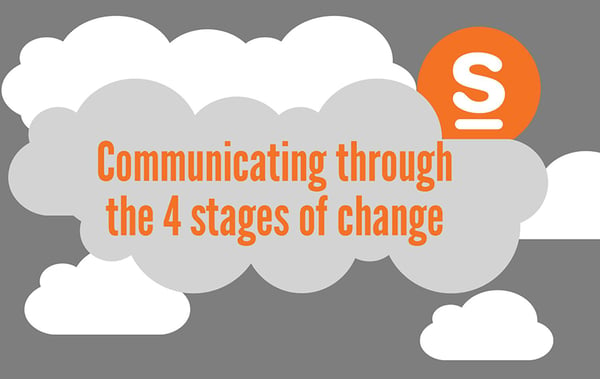
Bad news is always difficult to handle, whether you’re delivering it or receiving it. Unfortunately, in times of global COVID-19 disruption, there’s a lot of bad news around.
Financial hardship, closedowns, restructures and layoffs are commonplace. Many workplaces have suffered members of their team contracting the virus. It’s only natural for staff to feel uncertain. But uncertainty is bad for business. Employees don’t thrive when they feel nervous, vulnerable and confused.
Delivering bad news effectively is essential for maintaining morale, ensuring business competitiveness and protecting the brand. This is especially true today given the global economic downturn and difficult situations regarding workplace lockdowns, remote working, restrictions on movement and social isolation.
Psychology can tell us much about how people respond when receiving bad news. We’ve summarized the research to reveal five key reactions employees have to bad news – and recommended how internal communications should respond.
1. Feeling ambushed
When bad news is received, it’s often without warning. Situations develop fast and often responses must be as quick. Employees can feel taken by surprise and fear being out of the loop.
Response: Be prepared, be honest and be clear – don’t keep employees in the dark.
Frequent and honest communications are essential. If there’s a burning issue that needs addressing, be up front, but explain it may require time to work through.
Working from home means delivering bad news face-to-face is impossible. But staff need to see the conviction, hear the sincerity and feel the trust conveyed by managers. Leadership video messages are a much more effective option than a cold, corporate email.
Release new information quickly. Employees should always hear company news from the company first. Nothing is worse for morale than learning about changes from the media, family or friends.
2. Fixating on headlines
When confronted with bad news, there’s a tendency to fixate on the headlines and miss the detail – something called inattentional blindness.
Response: Communicate often to reinforce key messages – even if there’s not much to report.
Keep track of when staff last heard from you. Schedule in regular updates or follow-up meetings, even if you don’t expect to have anything ‘new’ to report. If you don’t know what the likely outcome of any negative situation will be, set up variations of messages and then publish them when the information is confirmed.
Use a campaign approach to maintain message momentum. Create a series of messages that are drip fed and repeated over a defined period. This structured approach raises staff awareness of the details, informs them of the evolving situation and involves them in the resolution.
3. Experiencing grief
Employees receiving bad news at work experience an emotional response similar to grief. Like grief, it can be immersive, long-lasting and provoke anxiety about what’s coming next.
Response: Recognize the cycle of acceptance and communicate appropriately through each stage.
The human response to receiving bad news follows something called the Change Curve. This is a series of stages progressing through blaming others, blaming self, uncertainty, acceptance, problem solving and moving on. Understanding this helps you predict how employees are likely to react. Different communication styles can then be employed to ease transition.
Focus on moving employees through each step – don’t try to immediately seek commitment. The length of time it takes to progress through the journey will vary depending on how momentous the bad news, how wide-reaching its affects and how resilient the employees involved.
Emphasize the importance of maintaining mental health and wellness and seeking support during this time.
4. Shooting the messenger
A common reaction when receiving bad news is to attack the messenger, rather than the message. Delivering bad news won’t win you any friends!
Response: Maintain a neutral tone in both voice and expression – avoid emotions.
Researchers identified that the two most important factors in giving bad news were facts and fairness. That is, providing adequate and reasonable explanations, and treating employees with dignity. Doing this removes any impression of the messenger not being impartial.
Frame the bad news in a way that shows clarity and honesty of intentions, without involving emotions. Employees will accept the news more readily if they believe the integrity of the messenger – and by extension, the message.
The result of not following neutrality is that staff may suspect you have an ulterior motive or ‘axe to grind’. This is when they’ll dig their heels in and the reaction can escalate into resistance.
5. Craving reassurance
Feeling vulnerable after receiving bad news creates a need for reassurance. Humans are social animals, so employees will want to seek support by sharing the news with trusted peers.
Response: Encourage feedback and respond to every point raised – no exceptions.
Include channels for feedback and discussion at the same time as the initial announcement. This signals goodwill and a desire to listen. Invite employees to share concerns with you confidentially. This strengthens the personal connection and provides time to prepare a more considered response.
Employee surveys or discussion forums can provide a way for staff to explore ideas and provide feedback. They can also help leaders gauge feeling within the organization. The type of questions being asked (for example “Is my job safe?” versus “What career opportunities are there?”) give a good indication of how people are feeling.
Bringing concerns out into the open lets you address them quickly, but close attention must be paid to ensure live conversations don’t quickly spiral out of control.
As businesses worldwide tackle the impacts of the coronavirus, being able to effectively deliver bad news is a critical communication skill. When bad news must be delivered, understanding the psychology of the response allows leaders to do so in the most appropriate, sensitive and effective way.
This article is adapted from one first published on the IABC website.




